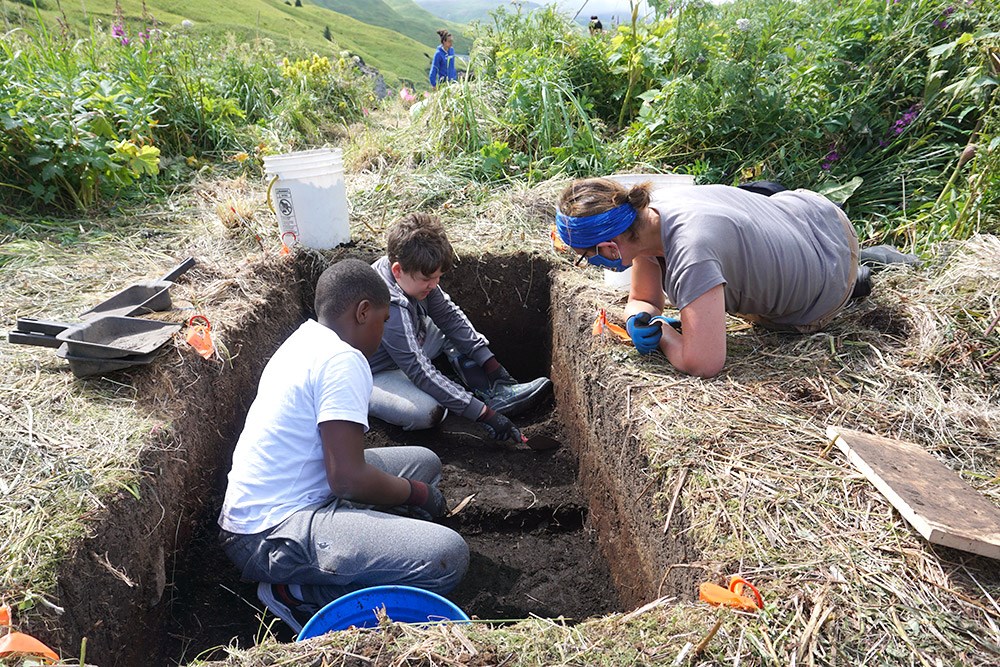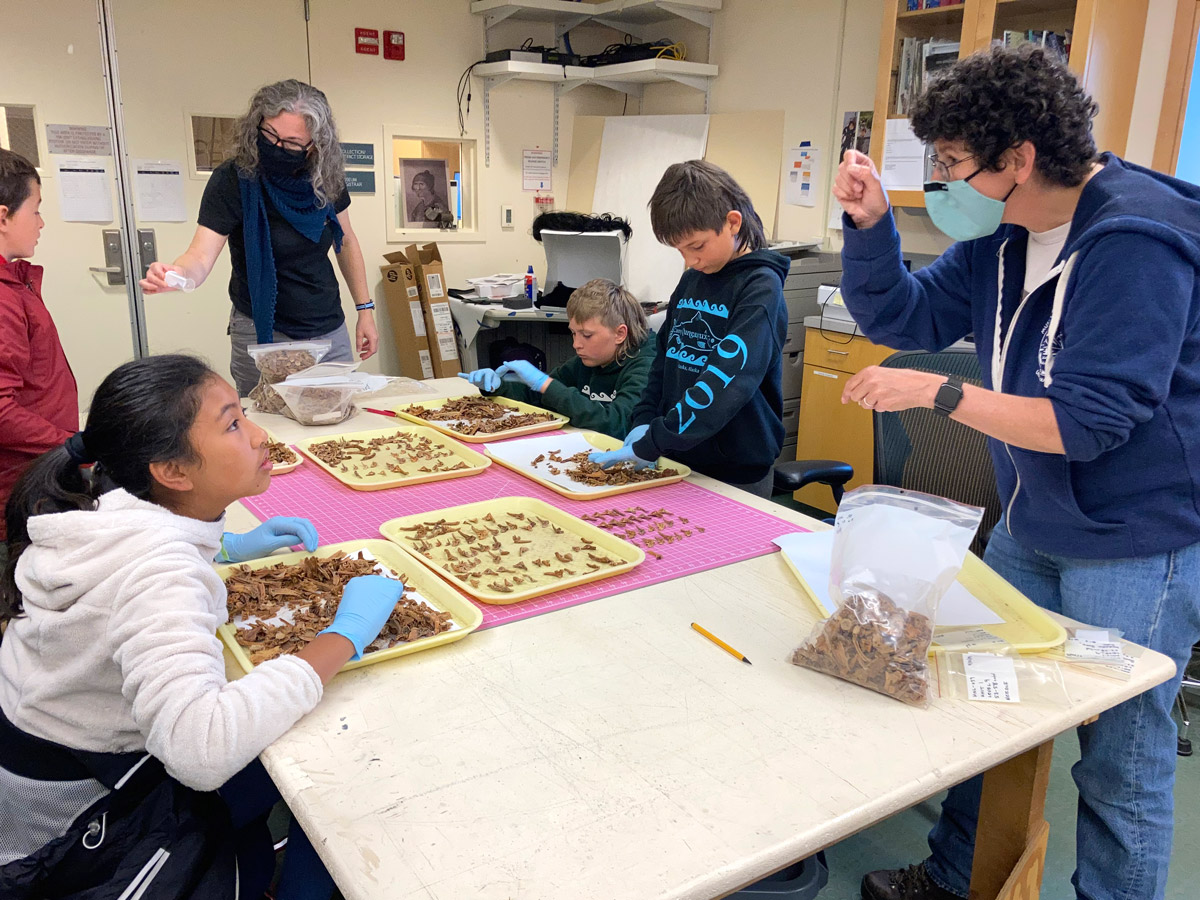August 31, 2021
by Caroline Funk

Dr. Nicole Misarti (CoI) works with culture camp kids at the Agnes Beach site, Unalaska. August 2021. Photo by Thomas McLenigan, Museum of the Aleutians.
Nicole Misarti and I sampled cod and otariid specimens for two weeks at the Museum of the Aleutians (MOTA). We worked in Unalaska site collections owned by the Ounalashka Corporation, which granted permission for our mercury project sampling.
I’m sitting in the Anchorage airport waiting for my long flight home to University at Buffalo as I write this and reflecting on the intense experience after months of pandemic delays for research. I am certain I touched more than a million fish and sea mammal bones as we worked our way through hundreds of bags of fish and sea mammal faunal remains from two villages lived in by ancestral Unangax 2000-3500 years ago. The sites were excavated in the late 1990s and early 2000s, and the materials are housed at MOTA.
Our second week coincided with Camp Qungaayux^, the annual culture camp for local kids. MOTA’s executive director, Virginia Hatfield, asked us to help out, and so we worked with museum staff for a few morning and afternoon sessions at the Agnes Beach site (UNL-046) excavation. The culture camp kids excavated and screened, participating in the careful archaeological methods we use to learn about past people and ways of living. They seemed intrigued by the idea that adults would lie on the ground in mucky rain gear and dig with teeny tiny trowels and dust pans. Kids are pretty adaptable evidently, and after staring big eyed for a bit, they had at it, finding rocks and flakes and greasy stains where people cooked dinner a few thousand years ago.
But then it rained.

Dr. Caroline Funk (CoI) and Dr. Virginia Hatfield (Executive Director, Museum of the Aleutians) mentoring culture campers during fish bone sampling in the museum lab, Dutch Harbor. August 2021. Photo by Nicole Misarti.
“They’re coming to the museum lab,” Virginia Hatfield announced with a little bit of drama when it was certain the excavation was rained out. “Ok,” I told her after a small anxiety lurch, “we can work with that.” Nicole and I prepared trays for sorting, weighed and prepped bags of archaeological fish remains, set aside cod bone specimens for comparison, and practiced talking about biogeochemical analysis of fish bones in fourth grade language. We masked up and waited for the stampede of kid energy.
They arrived, cautiously interested and more like careful fawns than stampeding bison, trapped by circumstance to endure what was on offer.
We explained our project, taking turns so their kid faces turned left and right like a knowledge tennis match. We handed out cod premaxillas, distinctive mouth parts that are easy to find in the massive fish bone collections. We talked about fish trophic positioning (which they understood just fine as they evidently have an excellent science program at school) and estimating fish size with premaxilla measurements (which also made sense to the kids – Dutch Harbor is the major US fishing port and fish size matters, a lot).
And then we dumped a mound of ancient fish bones on their trays. They looked like piles of weird potato chips. I waited, what would happen? The kids stared at the trays, stared at us.
“Got one!” a fourth grader held up a premaxilla. “Yep,” I said, “that’s the one, keep at it.” And the game was on. Nicole and I chatted about science, and collaborative research, and archaeological sites as inadvertent but complex ecological records. The crunchy sound of fish bones being picked through nearly drowned us out. The kids treated us like streaming video running in the background while they did something more interesting right in front of themselves, looking up when something piqued an interest.
“How do you think the ancestral Unangax who lived at this site got all of these cod?” I asked. Everyone stopped and looked at me. Again, this is a fishing town, and this was a serious question with a correct answer. “On a line?” someone offered. “Probably,” I said, and then we talked about fishing in the past and sampling implications for today’s study. Somehow this was working, the kids were doing scientific research with us, and they were putting pieces together.
First one, then two, then dozens of cod premaxillas filled the sample tray in the middle of the table. “How many did you get so far?” one boy asked the others. He thought his twenty-seven was the winner for sure. A girl across the table just pointed at her mound of premaxillas, clearly more than 27. “What?” the boy put his head back down, “can I have some more to sort?” Pick pick pick.
The cod premaxillas have tiny holes all over one side, the sockets for a lot of cod teeth that do not remain in the archaeological bone usually. Nicole showed the kids a picture of a cod skeleton, toothy mouth fully present. “Oooh.” Pick pick pick. “I got bit by a cod once,” the blond kid on the left announced to his tray. “Nah ah,” someone wasn’t buying it. “Well, I sort of made it bite me,” he held his hands up and imitated squeezing a dead fish mouth open and closed, open and closed. Everyone paused in their sorting to watch. They all giggled. We all giggled. It was really funny.
I hope the camp kids remember working with us to collect samples for our study. I hope they remember that science is interesting and complicated, and a lot of fun when working in a group of folks cooperating to know more. I sure won’t forget them.

Dr. Caroline Funk (CoI) and Dr. Virginia Hatfield (Executive Director, Museum of the Aleutians) work with culture camp kids at the Agnes Beach site, Unalaska. August 2021. Photo by Thomas McLenigan, Museum of the Aleutians.
Permission to use photos from the 2021 Camp Qungaayux^ was given by the tribe 9-15-2021. Should other photos from the camp be of interest, please contact Natasha Swint (natasha@qawalangin.com).